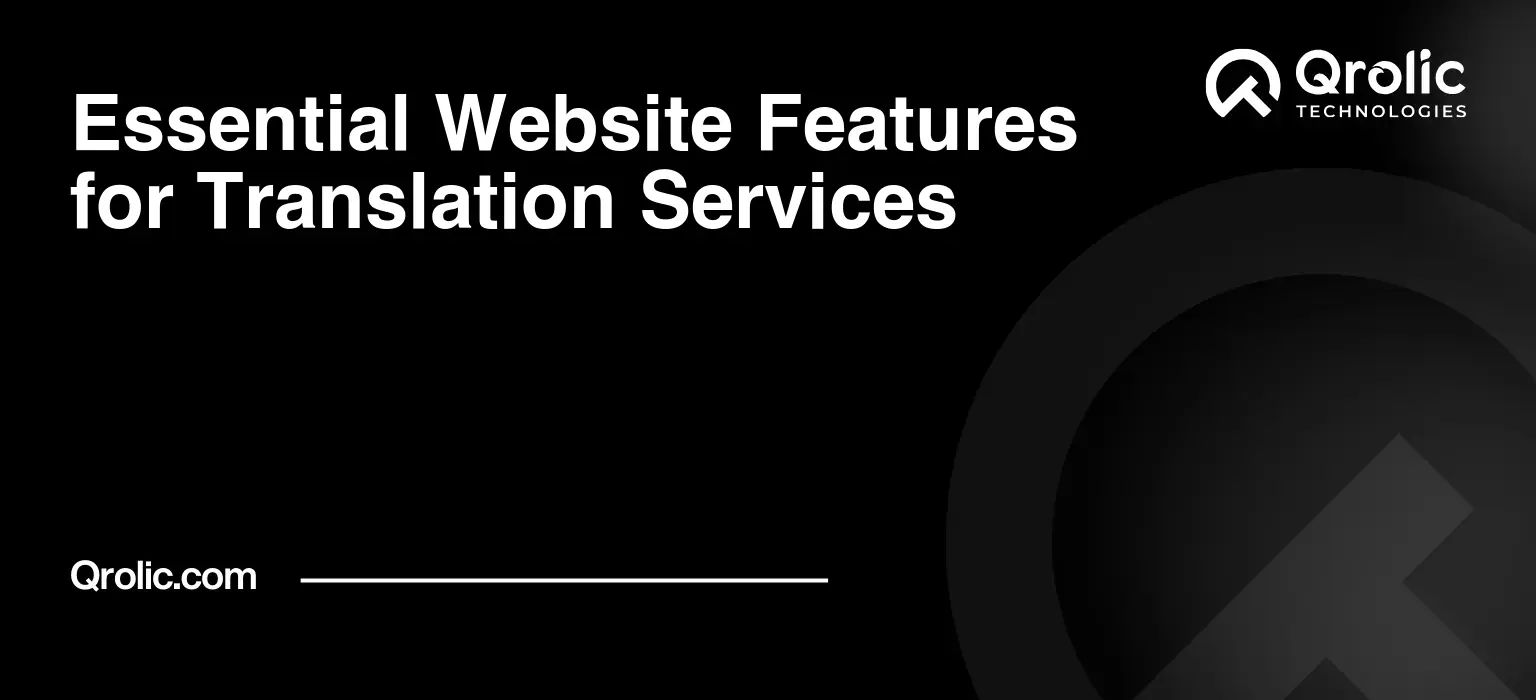In today’s globally connected world, a robust online presence is vital for any business, especially for translation services. Your website is often the first point of contact for potential clients, serving as a virtual storefront that must inspire confidence, demonstrate expertise, and facilitate seamless interaction. This comprehensive guide delves into the essential website features that can transform your translation services website from a mere online listing to a powerful lead-generating machine. We’ll explore the crucial elements that drive user engagement, improve search engine rankings, and ultimately, boost your bottom line.
Quick Summary:
- Build a clear, professional, and user-friendly website.
- Clearly list your services, languages, and team expertise.
- Showcase client testimonials and specific industry knowledge.
- Offer easy contact, quote forms, and multilingual options.
Table of Contents
- I. The Foundation: Core Website Elements
- A. A Clear and Concise Value Proposition
- B. Professional Design and User Experience (UX)
- C. Clear Navigation and Site Architecture
- D. High-Quality Content: Informative, Engaging, and SEO-Friendly
- E. Contact Information and a Clear Call to Action (CTA)
- II. Showcasing Your Expertise: Essential Features for Translation Services
- A. Detailed Service List with Language Pairs and Subject Matter Expertise
- B. A Prominent “Request a Quote” Form: Streamlined and User-Friendly
- C. Client Testimonials and Case Studies: Building Trust and Credibility
- D. Translator Profiles: Highlighting Expertise and Credentials
- E. Industry-Specific Content: Demonstrating Niche Expertise
- III. Driving Engagement and Conversions: Advanced Website Features
- A. A Blog with Regularly Updated, Relevant Content
- B. Multilingual Support: Catering to a Global Audience
- C. Integration with Translation Management Systems (TMS)
- D. Live Chat Support: Providing Instant Assistance
- E. Security Features: Protecting Sensitive Information
- IV. Qrolic Technologies: Your Partner in Digital Transformation
- V. Conclusion: Building a World-Class Translation Services Website
I. The Foundation: Core Website Elements
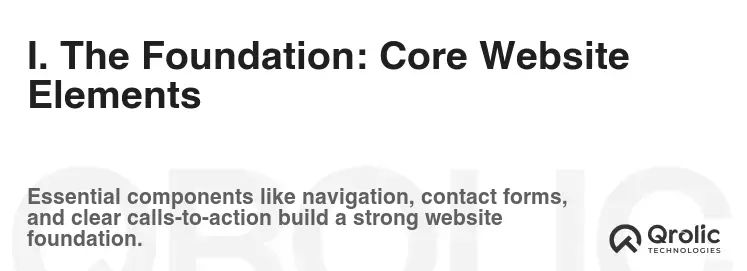
Before diving into specialized features, let’s establish the bedrock upon which your translation services website must be built. These core elements are non-negotiable for a professional and effective online presence.
A. A Clear and Concise Value Proposition
What: Your value proposition is a succinct statement that explains what your translation services offer, who your target audience is, and how you solve their problems. It’s the “why” someone should choose you over the competition.
Why: In the crowded online landscape, visitors need to understand immediately what you do and why you’re the best choice. A vague or confusing value proposition will send potential clients running to your competitors.
How:
- Identify Your Ideal Client: Who are you trying to reach? What are their specific needs and pain points related to translation?
- Highlight Your Unique Selling Proposition (USP): What makes your translation services different and better? Do you specialize in a specific industry, offer faster turnaround times, or have a team of native-speaking translators?
- Craft a Compelling Statement: Combine your target audience’s needs with your USP in a clear and concise statement. For example: “Providing accurate and culturally sensitive legal translations, ensuring your documents are legally sound and effective in any jurisdiction.”
Example:
- Weak: “We offer translation services.”
- Strong: “Get accurate, reliable, and certified translations for your medical documents, ensuring regulatory compliance and patient safety.”
B. Professional Design and User Experience (UX)
What: Professional design encompasses the visual appeal and layout of your website, while user experience focuses on how easy and enjoyable it is for visitors to navigate and interact with your site.
Why: A visually appealing and user-friendly website builds trust and credibility. It encourages visitors to stay longer, explore your services, and ultimately, become paying clients. A poorly designed website can create a negative impression and drive potential customers away.
How:
- Invest in Professional Design: Don’t settle for a generic template. Hire a professional web designer to create a custom design that reflects your brand identity and showcases your expertise.
- Prioritize User-Friendliness: Ensure your website is easy to navigate, with clear menus, intuitive layouts, and prominent calls to action.
- Mobile Optimization: In today’s mobile-first world, your website must be fully responsive and optimized for all devices, including smartphones and tablets.
- Fast Loading Speed: Optimize images and code to ensure your website loads quickly. slow loading times can frustrate visitors and negatively impact your search engine rankings.
- Accessibility: Design your website to be accessible to people with disabilities, adhering to WCAG guidelines.
Example:
- Use a clean and modern design with plenty of white space.
- Implement a clear and intuitive navigation menu.
- Ensure your website is mobile-friendly and loads quickly.
C. Clear Navigation and Site Architecture
What: Navigation refers to the structure and organization of your website, allowing users to easily find the information they need. Site architecture is the blueprint of your website, influencing both user experience and search engine optimization.
Why: A well-organized website makes it easy for visitors to find the services they need, learn about your expertise, and contact you. It also helps search engines understand your website’s content and rank it accordingly.
How:
- Plan Your Site Architecture: Map out the main pages of your website and how they will be linked together.
- Use Clear and Descriptive Labels: Use clear and concise labels for your navigation menu and links.
- Implement a Search Function: Allow visitors to search your website for specific keywords or phrases.
- Create a Sitemap: Submit a sitemap to Google Search Console to help search engines crawl and index your website.
Example:
- Use a simple and logical navigation menu with categories such as “Services,” “About Us,” “Industries,” “Blog,” and “Contact.”
- Include a search bar in the header or footer of your website.
D. High-Quality Content: Informative, Engaging, and SEO-Friendly
What: High-quality content is the backbone of any successful website. It provides valuable information to your target audience, engages them with your brand, and improves your search engine rankings.
Why: Content is what attracts visitors to your website and keeps them coming back. Informative, engaging, and SEO-friendly content establishes you as an authority in your field and helps you rank higher in search engine results.
How:
- Understand Your Audience: Identify the questions and concerns of your target audience and create content that addresses them.
- Create a Content Calendar: Plan your content creation in advance to ensure a consistent flow of new and relevant content.
- Optimize for SEO: Use relevant keywords, optimize your title tags and meta descriptions, and build high-quality backlinks.
- Vary Your Content Formats: Use a mix of text, images, videos, and infographics to keep your audience engaged.
- Proofread and Edit: Ensure your content is free of errors in grammar and spelling.
Example:
- Write blog posts about industry trends, translation tips, and case studies.
- Create informative videos about your translation process and the benefits of using your services.
- Share your content on social media to reach a wider audience.
E. Contact Information and a Clear Call to Action (CTA)
What: Contact information provides visitors with the means to reach you, while a call to action encourages them to take a specific action, such as requesting a quote or contacting you for more information.
Why: Making it easy for potential clients to contact you is crucial for generating leads and closing deals. A clear call to action guides visitors towards the next step in the sales process.
How:
- Display Contact Information Prominently: Include your phone number, email address, and physical address (if applicable) on every page of your website.
- Create a Contact Form: Provide a contact form for visitors to easily submit their inquiries.
- Use Strong Calls to Action: Use clear and compelling calls to action, such as “Request a Free Quote,” “Contact Us Today,” or “Get Started Now.”
- Place CTAs Strategically: Place your calls to action in prominent locations on your website, such as above the fold, in the sidebar, and at the end of your content.
Example:
- Include a “Contact Us” button in the header and footer of your website.
- Use a contact form with fields for name, email address, phone number, and message.
- Place a “Request a Free Quote” button on your services pages.
II. Showcasing Your Expertise: Essential Features for Translation Services
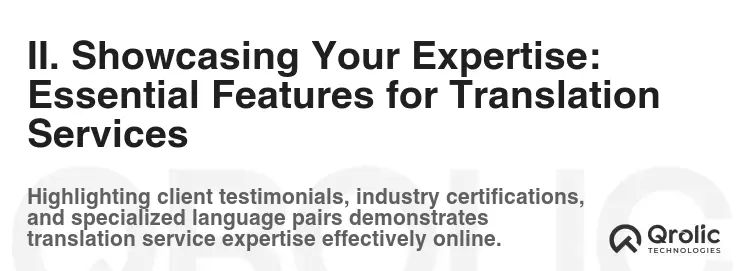
Beyond the basic website elements, certain features are particularly important for showcasing your expertise and building trust with potential clients in the translation services industry.
A. Detailed Service List with Language Pairs and Subject Matter Expertise
What: A comprehensive service list clearly outlines the types of translation services you offer, the language pairs you support, and the industries you specialize in.
Why: Potential clients need to know if you can handle their specific translation needs. A detailed service list demonstrates your capabilities and helps them determine if you’re a good fit for their project. Furthermore, focusing on specific language pairs enhances your SEO by targeting niche keywords.
How:
- List All Your Services: Include all the different types of translation services you offer, such as document translation, website localization, software localization, interpretation, transcription, and proofreading.
- Specify Language Pairs: Clearly state the language pairs you support, such as English to Spanish, French to German, or Mandarin to English.
- Highlight Subject Matter Expertise: Indicate the industries you specialize in, such as legal, medical, technical, financial, or marketing.
- Use Descriptive Language: Use clear and descriptive language to explain each service and its benefits.
- Organize Your Service List: Organize your service list in a logical and easy-to-navigate manner, using headings, subheadings, and bullet points.
Example:
- Document Translation: Accurate and reliable translation of all types of documents, including legal contracts, technical manuals, and marketing materials. Language pairs: English to Spanish, Spanish to English, French to English, German to English. Subject matter expertise: Legal, Medical, Technical.
- Website Localization: Adapting your website for different languages and cultures, ensuring a seamless user experience for your international audience. Language pairs: English to Spanish, French to German, Mandarin to English. Subject matter expertise: Marketing, E-commerce, Technology.
B. A Prominent “Request a Quote” Form: Streamlined and User-Friendly
What: A “Request a Quote” form is a crucial tool for capturing leads and providing potential clients with a quick and easy way to get a price estimate for their translation project.
Why: A streamlined and user-friendly quote form encourages potential clients to take the next step and engage with your services. It also allows you to gather the information you need to provide an accurate and competitive quote. Quote forms also give direct information on what type of clients are interacting with your website.
How:
- Make It Easy to Find: Place your quote form prominently on your website, such as in the header, sidebar, or on a dedicated “Request a Quote” page.
- Keep It Simple: Only ask for the essential information you need, such as the source and target languages, the document type, the word count, and the desired turnaround time.
- Use Clear Labels and Instructions: Use clear labels and instructions for each field to guide users through the form.
- Provide Options for Uploading Documents: Allow users to upload their documents directly to the form for a more accurate quote.
- Offer a Confirmation Message: Display a confirmation message after the form is submitted to let users know that their request has been received.
- Automated Response: Set up an automated email response to immediately acknowledge the quote request and provide an estimated timeframe for the quote.
Example:
- Form Fields:
- Name
- Email Address
- Phone Number (Optional)
- Source Language
- Target Language(s)
- Document Type
- Word Count (Approximate)
- Desired Turnaround Time
- Document Upload (Optional)
- Message
C. Client Testimonials and Case Studies: Building Trust and Credibility
What: Client testimonials and case studies provide social proof and demonstrate the value of your translation services to potential clients.
Why: Testimonials from satisfied clients build trust and credibility, while case studies showcase your expertise in solving real-world translation challenges.
How:
- Gather Testimonials: Request testimonials from your satisfied clients, highlighting their positive experiences with your services.
- Showcase Results: Focus on the specific results you achieved for your clients, such as improved accuracy, faster turnaround times, or increased customer satisfaction.
- Use Real Names and Photos: Use real names and photos of your clients to make your testimonials more authentic.
- Create Case Studies: Develop in-depth case studies that showcase your expertise in solving complex translation challenges.
- Highlight the Problem, Solution, and Results: Each case study should clearly outline the problem, the solution you provided, and the results you achieved.
Example:
- Testimonial: “We have been using [Translation Company Name] for all our legal translation needs for the past five years. Their accuracy, reliability, and attention to detail are unmatched. They have consistently delivered high-quality translations that have helped us win cases and grow our business.” – [Client Name], [Client Title], [Client Company]
- Case Study: “[Translation Company Name] helped a leading medical device manufacturer translate its user manuals and marketing materials into five different languages. The result was a 20% increase in sales in international markets.”
D. Translator Profiles: Highlighting Expertise and Credentials
What: Translator profiles introduce your team of translators, highlighting their expertise, credentials, and language skills.
Why: Potential clients want to know who will be handling their translation projects. Translator profiles build trust and demonstrate your commitment to quality by showcasing the qualifications of your team.
How:
- Include Photos: Use professional photos of your translators to create a personal connection with visitors.
- Highlight Expertise and Credentials: List each translator’s language skills, education, certifications, and areas of expertise.
- Write Compelling Biographies: Write brief biographies that highlight each translator’s experience and passion for translation.
- Showcase Language Proficiency: Clearly indicate each translator’s native language and level of proficiency in other languages.
Example:
- Translator Profile:
- [Translator Name]
- [Translator Photo]
- Native Language: Spanish
- Fluent in: English
- Education: Master’s Degree in Translation
- Certifications: ATA Certified Translator
- Expertise: Legal, Medical
- Biography: [Translator Name] is a highly experienced translator with over 10 years of experience in the legal and medical fields. She is passionate about ensuring accurate and culturally sensitive translations that meet the highest standards of quality.
E. Industry-Specific Content: Demonstrating Niche Expertise
What: Industry-specific content targets specific industries or sectors, demonstrating your expertise and understanding of their unique translation needs.
Why: Content that speaks directly to the needs of a particular industry attracts qualified leads and establishes you as a trusted partner. It also improves your search engine rankings for industry-specific keywords.
How:
- Identify Target Industries: Identify the industries you want to target, such as legal, medical, technical, financial, or marketing.
- Create Industry-Specific Landing Pages: Create dedicated landing pages for each industry, highlighting your relevant services and expertise.
- Write Blog Posts and Articles: Write blog posts and articles that address the specific translation challenges faced by each industry.
- Share Case Studies: Share case studies that showcase your success in solving translation challenges for clients in each industry.
Example:
- Legal Translation: “Accurate and reliable legal translations for contracts, patents, and other legal documents. Our team of experienced legal translators understands the nuances of legal terminology and ensures that your documents are legally sound and effective in any jurisdiction.”
- Medical Translation: “Certified medical translations for clinical trials, patient records, and medical device manuals. We adhere to strict quality control standards to ensure the accuracy and safety of your medical translations.”
III. Driving Engagement and Conversions: Advanced Website Features
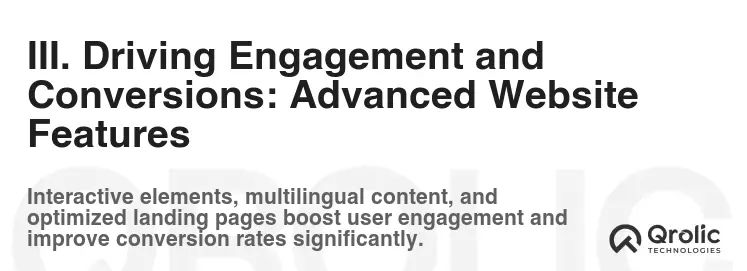
Once you’ve established the core elements and showcased your expertise, it’s time to focus on driving engagement and conversions with advanced website features.
A. A Blog with Regularly Updated, Relevant Content
What: A blog is a platform for publishing regularly updated, relevant content that attracts visitors, engages them with your brand, and improves your search engine rankings.
Why: A blog helps you establish yourself as an authority in the translation industry, attract qualified leads, and drive traffic to your website.
How:
- Create a Content Calendar: Plan your blog content in advance to ensure a consistent flow of new and relevant articles.
- Write High-Quality Articles: Write informative, engaging, and SEO-friendly articles that address the needs and interests of your target audience.
- Promote Your Blog: Share your blog posts on social media, email newsletters, and other marketing channels.
- Engage with Your Audience: Respond to comments and questions from your readers.
- Optimize for SEO: Use relevant keywords, optimize your title tags and meta descriptions, and build high-quality backlinks.
Example:
- Blog Topics:
- The Importance of Accurate Translation in the Legal Industry
- How to Choose the Right Translation Service for Your Business
- The Benefits of Website Localization for Global Expansion
- The Latest Trends in the Translation Industry
- Tips for Working with a Translator
B. Multilingual Support: Catering to a Global Audience
What: Multilingual support allows you to display your website in multiple languages, catering to a global audience and expanding your reach.
Why: Offering your website in multiple languages makes it easier for potential clients to find you and understand your services, regardless of their native language.
How:
- Choose a Multilingual Platform: Use a website platform that supports multilingual functionality, such as wordpress with a translation plugin.
- Translate Your Website Content: Translate all of your website content into the target languages, including your text, images, and videos.
- Use a Language Switcher: Implement a language switcher that allows visitors to easily select their preferred language.
- Optimize for SEO: Optimize your website for each language, using relevant keywords and building high-quality backlinks.
Example:
- Use a language switcher in the header of your website that allows visitors to select their preferred language from a dropdown menu.
- Translate your website content into Spanish, French, German, and Mandarin.
C. Integration with Translation Management Systems (TMS)
What: Integration with a Translation Management System (TMS) streamlines the translation process and improves efficiency.
Why: A TMS automates many of the tasks involved in translation, such as project management, terminology management, and quality assurance. This can save you time and money, and ensure consistent quality across all your translation projects.
How:
- Choose a TMS: Select a TMS that meets your specific needs and requirements.
- Integrate with Your Website: Integrate your TMS with your website to automate the process of receiving and managing translation requests.
- Automate Workflows: Automate your translation workflows to reduce manual tasks and improve efficiency.
- Manage Terminology: Use the TMS to manage your terminology and ensure consistent usage across all your translation projects.
Example:
- Use a TMS to automatically assign translation projects to qualified translators based on their language skills and subject matter expertise.
- Integrate your TMS with your website to automatically generate quotes for translation requests.
D. Live Chat Support: Providing Instant Assistance
What: Live chat support allows you to provide instant assistance to visitors on your website, answering their questions and guiding them through the sales process.
Why: Live chat support improves customer satisfaction, increases conversions, and provides valuable insights into your customers’ needs and concerns.
How:
- Choose a Live Chat Platform: Select a live chat platform that integrates with your website.
- Train Your Staff: Train your staff to provide prompt and helpful responses to customer inquiries.
- Monitor Chat Sessions: Monitor chat sessions to ensure that your staff is providing high-quality support.
- Analyze Chat Data: Analyze chat data to identify trends and improve your customer service.
Example:
- Use live chat to answer questions about your translation services, provide quotes, and schedule consultations.
- Offer live chat support in multiple languages to cater to your international audience.
E. Security Features: Protecting Sensitive Information
What: Security features protect your website and your clients’ sensitive information from cyber threats.
Why: Security is essential for building trust with your clients and protecting your business from data breaches and other security incidents.
How:
- Install an SSL Certificate: Install an SSL certificate to encrypt the data transmitted between your website and your visitors.
- Use Strong Passwords: Use strong passwords for all your website accounts.
- Keep Your Software Up to Date: Keep your website software and plugins up to date with the latest security patches.
- Implement a Firewall: Implement a firewall to protect your website from malicious traffic.
- Regularly Back Up Your Website: Regularly back up your website to protect against data loss.
IV. Qrolic Technologies: Your Partner in Digital Transformation

At Qrolic Technologies (https://qrolic.com/), we understand the unique challenges and opportunities that translation services face in the digital age. We offer a comprehensive suite of digital solutions designed to help you build a powerful online presence, attract qualified leads, and grow your business.
Our Services Include:
- Website Design and Development: We create custom websites that are visually appealing, user-friendly, and optimized for search engines.
- SEO Services: We help you improve your search engine rankings and drive more traffic to your website.
- Content Marketing: We create high-quality content that attracts visitors, engages them with your brand, and establishes you as an authority in your field.
- Social Media Marketing: We help you build a strong social media presence and connect with your target audience.
- PPC Advertising: We help you run effective pay-per-click advertising campaigns that generate leads and drive sales.
We are committed to providing our clients with the highest quality services and support. Contact us today to learn more about how we can help you transform your translation services business.
V. Conclusion: Building a World-Class Translation Services Website
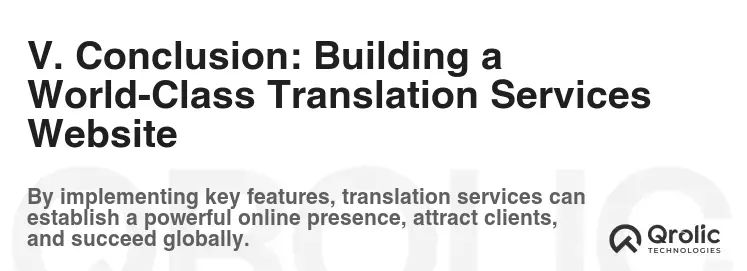
Creating a world-class website for your translation services business requires a strategic approach that focuses on providing value to your target audience, showcasing your expertise, and driving engagement and conversions. By implementing the essential website features outlined in this guide, you can build a powerful online presence that attracts qualified leads, establishes you as a trusted partner, and ultimately, helps you grow your business. Remember to continuously monitor your website’s performance, analyze user behavior, and make adjustments as needed to ensure that your website is always working effectively for you. In conclusion, translation services are a complex market, and therefore requires attention to the details laid out in this article, to provide any website a competitive edge over its competitors.
